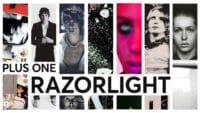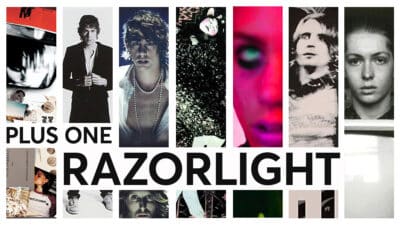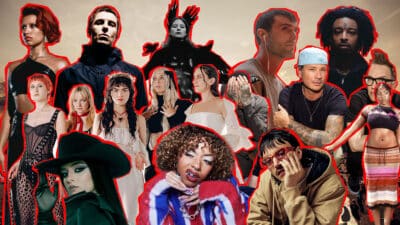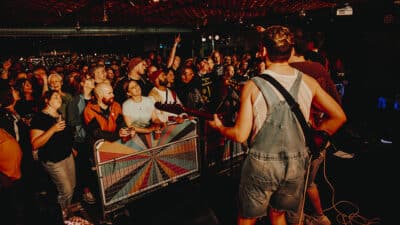Music

Feature
WTF is… indie sleaze
From The Strokes to Skins to brat summer: why the era that never was is coming back in style
Unless you’ve spent the last few months trapped under a rock, you’ll have probably crossed paths with someone living their brat summer.
To those not in the know, the cultural trend followed the release of Charli XCX’s latest album, Brat, with a white-hot reception and an ensuing swell in the numbers of Charli’s Angels. Within weeks, the ‘brat mentality’ grew from fan-contributed alternate covers and TikTok dances to become something the mainstream media were doing their best to try and understand. Even US Vice President Kamala Harris rode the trend as part of her presidential campaign, a strategic move made less beggy with the ringing endorsement “Kamala is brat” from Charli herself.
But why does everyone want to be a ‘brat’ now? No longer just an infantilising insult, ‘brat’ encourages self-discovery and harnesses empowerment. Just as Megan Thee Stallion perfectly framed the mood of 2019 with ‘hot girl summer’, the lime-green movement has bottled the zeitgeist in a loose yet stylish fashion. Think messy eyeliner, DIY outfits and star-shaped pimple patches kept on as an accessory. In a way, trying to describe brat isn’t very brat at all, so who better than Miss XCX to explain: “You’re just like that girl who is a little messy and likes to party and maybe says dumb things sometimes.”
So brat is about embracing imperfection and the chaos of your mistakes. The pop cultural pendulum has moved away from the dominating trends of ‘quiet luxury’, ‘stealth wealth’ and the ‘clean girl aesthetic’ that ruled the 2020s and back into the familiar messy territory of indie sleaze. Sharing its effortless cool style and a playfully nihilistic pleasure seeking vibe, the fundamental values seem very much a legacy of noughties cool. Could brat be the fresh face of the long heralded indie sleaze revival? And what does that even mean?
The origins of indie sleaze

Indie sleaze has existed since 2021. So why is there a growing fascination with an aesthetic that peaked a decade before the term was even coined, and where did indie sleaze come from?
The genre’s cultural origins go as far back as the garage indie rock boom of Y2K. Grunge gave young people a new sense of cultural identity and recognition and then it mostly just drifted out of existence after the mid 90s. In its place was left a tide of overproduced mainstream rock in the age of MTV, earning it the derisive label of ‘butt rock’.
It was into this vacuum that The Strokes burst in 2001 with their trailblazing debut Is This It. While superficially bright and optimistic, The Strokes’ sound bubbled under the surface with a real lusting sense of nostalgia and romantic melancholy. On stage, with near-perfect timing and an impressive dynamic of interlocking guitar parts, The Strokes were a well-oiled mechanical engine. Matched by the impressive intensity of Julian Casablancas’ vocals and stage presence, the band showed other groups what was possible. From that point on, a new cultural revolution had begun.
NYC downtown fashion quickly became the standard. Clubs were awash with tight trousers, bed hair and flea market leather jackets. More US indie groups such as Yeah Yeah Yeahs and Interpol gained prominence. Converse sold out everywhere.
Leading the UK charge was The Libertines. Despite being initially billed as “The English Strokes”, much to the groups chagrin, their 2002 debut record Up The Bracket showcased their very different sound. Although far from polished, The Libertines achieved a captivating chaos that was idiosyncratic in its Britishness.
While The Strokes offered a technical roadmap to the new indie genre, The Libertines – with their charming ‘dangerous to know’ influence – attached a hedonistic appetite to the developing 21st century rockstar archetype. As if cosplaying some punk vision of The Beatles during Sgt Pepper, Co-leads Pete Doherty and Carl Barat sported red Army tunic jackets from the video of their hit ‘Don’t Look Back Into The Sun’. Soon Camden would be dogged with countless copycats wearing dangling rosary bead necklaces, military jackets, overcoats, skinny jeans and trilby hats hoping to attain a modicum of their idols effortless cool.
Doherty’s fame would quickly eclipse his bandmates, but almost entirely for the wrong reasons. His high profile relationship with supermodel Kate Moss became a perfect storm; an indie moment in time to go down in pop culture history. The pictures of them perfectly dressed but nonetheless caked in mud crossing a field at Glastonbury are classic indie sleaze.
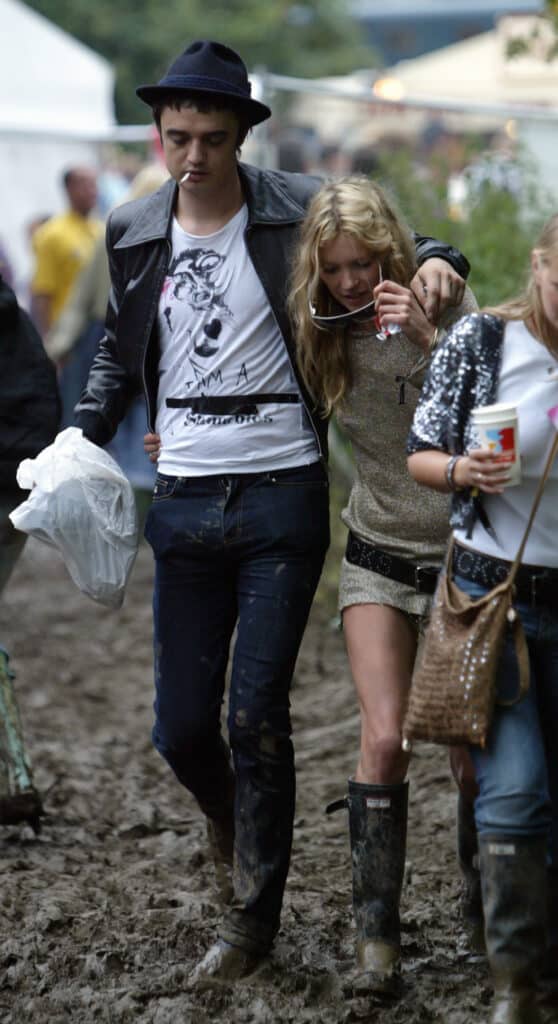
The growing storm of controversy would eventually mean curtains for The Libertines. But not before they delivered a seminal self-titled break up album in 2004 (paving the way for the comeback tour we’re now in the midst of). Very much the rough indie version of Rumours, all the discontent in the band was laid bare in the lead single ‘Can’t Stand Me Now’. Within the year The Libertines were over but the legacy they left behind was significant. Doherty, in particular, had created many peoples ideal of new British rockstar. While they were unlikely to be bested in their unhealthy appetite for hedonism and self destruction, the golden era of indie sleaze was now on the horizon.
The heyday of indie sleaze
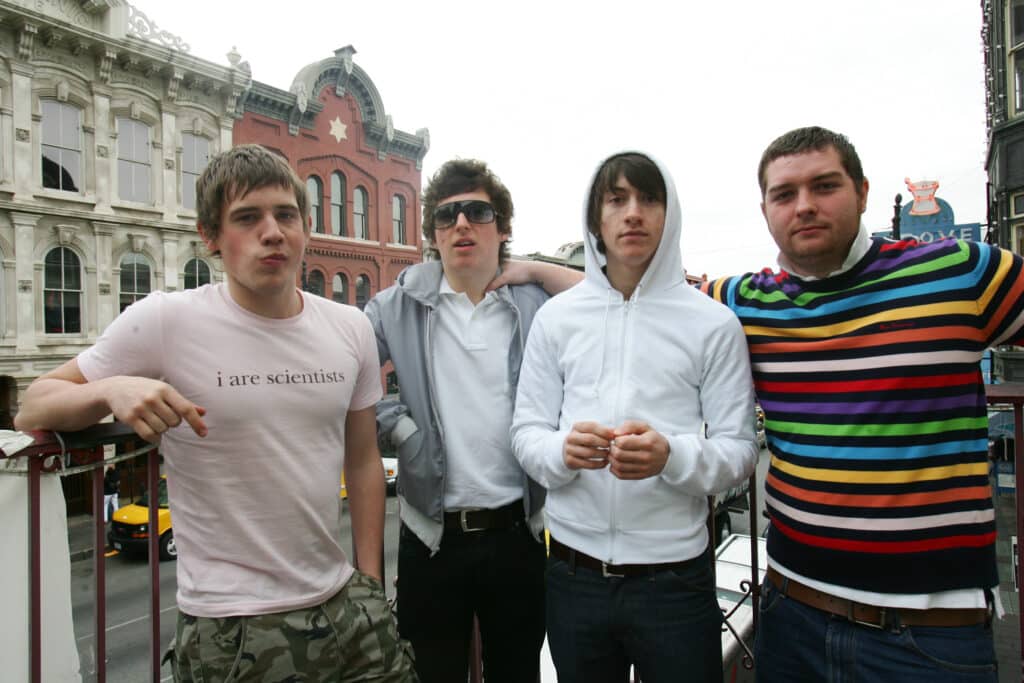
“Growing up I wanted to be Pete Doherty, he was literally a cultural icon. [The Libertines….] had that sticky dance floor sound that you couldn’t find anywhere else.”
Peace Okezie AKA Master Peace
Smudged black eyeshadow. Laddered tights. Men in painfully skinny black drainpipes. House parties and drunk celebrities getting carried out of clubs. For indie sleaze gatekeepers, the period roughly stretching from 2006 to around 2012 was the start and end of everything. A golden age for its two key ingredients, the music and the style…
As the new millennium really got going indie music had become a hot mainstream commodity, with bands such as Arctic Monkeys and Franz Ferdinand becoming the new cultural heroes. Fronted by the charismatic yet relatable Alex Turner – one part jack the lad, one part precocious poet – Arctic Monkeys presented indie with a promising new future. Their 2006 debut album Whatever People Say I Am That’s What I’m Not boasted sophisticated lyrical narratives delivered at rapid pace, offering fans a fly on the wall insight, warts and all, into their party lifestyle. Following in Doherty’s footsteps (albeit in a much cleaner, more marketable, way), frontman Alex Turner’s relationship with model and fashion blogger Alexa Chung was one of the most talked about pairings of the period – and this is really where the internet start to have a field day with the aesthetic.
As indie stylings became a broader bracket, eclectic groups such as Foals swayed the scene in a more atmospheric direction, shedding the previously minimal purist guitar music approach. With intricate riffs and pulsating rhythms, Foals brought an emotive and introspective dance sound to the table, opening the door to math rock.
Matching the increasingly optimistic vibe of the time, groups such as MGMT added a new upbeat psychedelic dimensions to the genre. Harnessing previously underutilised synths in their sound, the group’s soaring melodies became summer anthems for muddy festivals and lo-fi tinny speaker sessions drinking outdoors alike. With whimsical lyrics and surrealist elements, MGMT gave newfound credibility to a style of indie music that didn’t take itself so seriously, offering a new contrast to the grittier sounds of their predecessors. With a similar sun-soaked vibe, Vampire Weekend emerged as a significant force within the indie sphere, bringing a timelessly fresh, preppy aesthetic and bright sharply defined sound that confidently stood apart from the more rugged styles of the group’s one-time rock peers. Their music was characterised by elaborate baroque structures and clever lyrics, allowing the group to resonate with a wider audience.
And then there was the biggest non-musical influence on indie sleaze: the cult British TV show Skins. Boys wanted to be James, the troubled rebel without a cause brilliantly portrayed by now-Hollywood leading man Jack O’Connell, and girls wanted to be Effy, Kaya Scodelario’s beautiful mysterious troublemaker. Skins raw, unflinching portrayal of teenage life – complete with wild parties, emotional turmoil, and edgy fashion – mirrored and amplified the self-indulgence and rebellious spirit of the indie sleaze era. The show’s characters became style icons, influencing fans to embrace a similarly unpolished and carefree aesthetic. As a rite of passage for teens of then and now, Skins continues to be romanticised and paid homage to in endless stan accounts online. Speaking of the internet’s influence…
The myth of indie sleaze
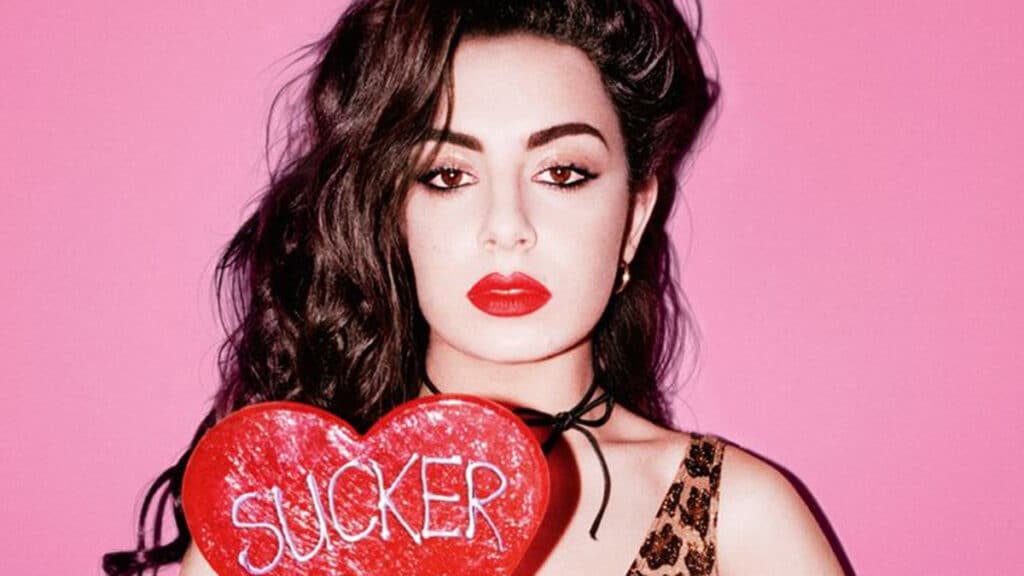
So basically anything in NME up to 2012 can be deemed indie sleaze, right? To a certain extent, yes. But this is where definitions of the umbrella term get complicated, as the first documented use of “indie sleaze” actually came years after its heydey.
In January 2021, Olivia V tapped into a collective longing for the recent Belle Epoque, launching her instantly popular instagram account with its handle @indiesleaze; coining the term which has had surging relevance ever since. @indiesleaze carefully curated a selection of raw and unpolished imagery, all seemingly borrowed from the online memory of Myspace and Tumblr via the Wayback Machine. With its live-action shots of iconic gigs taken on old Sony point-and-shoot cameras and gritty candid relics of underground raves, it perfectly encapsulates the era in essence, for all its chaos.
The account provided a much-needed visual showcase of the fashion, music and indie culture of the 2000 to early 2010s era, a period which many remember fondly and others wish they had been a part of. Later on, in 2021, the concept was expanded on by music journalist and trend predictor Mandy Lee. She claimed indie sleaze was on track for an imminent revival – brought on by Gen Z’s need for commodified nostalgia and an escape to a time of freedom and authenticity that now feels absent in the age of polished social media content.
So where does that leave the indie sleaze. Is it a genuine revival of indie culture or just a rebranded myth?
At face value, indie sleaze may seem to be the cherry pickings of a generation that wasn’t even present. However, the resurgence of interest in the era’s music, culture and aesthetics can also be seen as a genuine desire to recapture a spirit. It was ironically this same craving that was present throughout the ‘heydey’ of indie sleaze (if that ever existed…) and the very same driving cultural yearning that pushed The Strokes to create a new Velvet Underground infused sound. And as Alex Turner neatly put it on a track from Arctic Monkeys 2018 release Tranquility Base Hotel & Casino, “I just wanted to be one of The Strokes”…
By scratching off the flaky cool modern veneer of any wave of indie like an old layer of nail varnish, you would likely find a deep sense of nostalgia. A need to look backwards to rediscover the authenticity that seemed more possible in eras gone when everyone was having more fun.
The complicated legacy of indie sleaze
Every now and again something turns the dial up and the rolling boil of online chatter about the indie sleaze revival gets louder. From brat to documentaries such as Meet Me In The Bathroom, the fascination with the post-millenia indie era seems ever present with a whole new generation willing it to break back through the surface in some fresh new form. But this raises the question: what would that even look like?
For one thing, The Strokes era existed long before Olivia V and Mandy Lee gave the period a new name. There would be no indie sleaze for Gen Z to canonise and rediscover for themselves without the internet and its TikTok/Instagram hive mind. So surely any definition of that period of time can only ever be skewed when seen through rose tinted wayfarers.
This point was highlighted by the online reaction to Emerald Fennell’s 2023 thriller Saltburn. Set at the height of indie sleaze, the film’s time machine ride through the fashion, music and heightened decadence presented Gen Z fans with an ornate portrait of an era that existed long before the same social platforms arrived that romanticised it. Of course the era wasn’t all glamour – no matter how much it seem when you weren’t there to begin with. Sometimes the dirty kids of @indiesleaze just needed a wash, no matter how stylish their faded t-shirt and indigo skinny jean combo was.
But does that matter? The returning trend for the era has made possible the reemergence and fresh relevance of some of the most influential bands that soundtracked the indie golden era such as The Kills, Justice and LCD Soundsystem.
In a climate where musical genres and cultural styles are losing their rigidity, it’s all too common to look back in wonder at the last period where they seemed to have strength and integrity. With her unique style and non conformist attitude, Charli XCX has encouraged a new generation to embrace their individuality. While brat shares much of the same visual language, tongue in cheek tropes and party hard ideals of the indie sleaze period, the uniquely feminine take would have likely been less welcome at the time.
While indie sleaze might not mean anything at all – about as much as brat – the underlying yearning for authenticity is only becoming more important. Don’t throw those old Converse out just yet…
The Libertines start their UK tour in September, with tickets available here.
Charli XCX brings her BRAT 2024 tour to UK arenas this November, with tickets available here.
Photo credit: John Powell/Avalon/Getty Images




